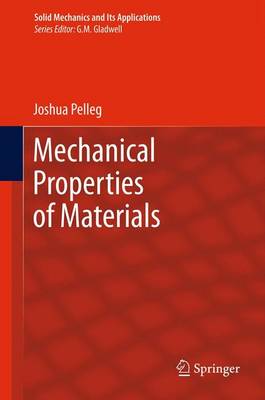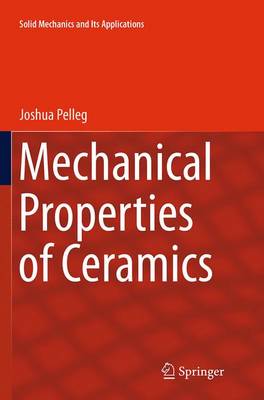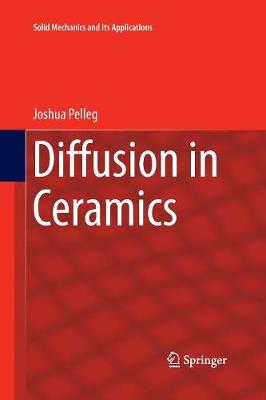Solid Mechanics and Its Applications
4 primary works
Book 190
The subject of mechanical behavior has been in the front line of basic studies in engineering curricula for many years. This textbook was written for engineering students with the aim of presenting, in a relatively simple manner, the basic concepts of mechanical behavior in solid materials. A second aim of the book is to guide students in their laboratory experiments by helping them to understand their observations in parallel with the lectures of their various courses; therefore the first chapter of the book is devoted to mechanical testing. Another aim of the book is to provide practicing engineers with basic help to bridge the gap of time that has passed from their graduation up to their actual involvement in engineering work.
The book also serves as the basis for more advanced studies and seminars when pursuing courses on a graduate level.
The content of this textbook and the topics discussed correspond to courses that are usually taught in universities and colleges all over the world, but with a different and more modern approach. It is however unique by the inclusion of an extensive chapter on mechanical behavior in the micron and submicron/nanometer range. Mechanical deformation phenomena are explained and often related to the presence of dislocations in structures. Many practical illustrations are provided representing various observations encountered in actual structures of particularly technical significance. A comprehensive list of references at the end of each chapter is included to provide a broad basis for further studying the subject.
Book 213
This book discusses the mechanical properties of ceramics and aims to provide both a solid background for undergraduate students, as well as serving as a text to bring practicing engineers up to date with the latest developments in this topic so they can use and apply these to their actual engineering work.
Generally, ceramics are made by moistening a mixture of clays, casting it into desired shapes and then firing it to a high temperature, a process known as 'vitrification'. The relatively late development of metallurgy was contingent on the availability of ceramics and the know-how to mold them into the appropriate forms. Because of the characteristics of ceramics, they offer great advantages over metals in specific applications in which hardness, wear resistance and chemical stability at high temperatures are essential. Clearly, modern ceramics manufacturing has come a long way from the early clay-processing fabrication method, and the last two decades have seen the development of sophisticated techniques to produce a large variety of ceramic material.
The chapters of this volume are ordered to help students with their laboratory experiments and guide their observations in parallel with lectures based on the current text. Thus, the first chapter is devoted to mechanical testing. A chapter of ductile and superplastic ceramic is added to emphasize their role in modern ceramics (chapter 2). These are followed by the theoretical basis of the subject. Various aspects of the mechanical properties are discussed in the following chapters, among them, strengthening mechanisms, time dependent and cyclic deformation of ceramics. Many practical illustrations are provided representing various observations encountered in actual ceramic-structures of particularly technical significance. A comprehensive list of references at the end of each chapter is included in this textbook to provide a broad basis for further studying the subject. The work also contains a unique chapter on a topic not discussed in other textbooks on ceramics concerning nanosized ceramics.
This work will also be useful as a reference for materials scientists, not only to those who specialize in ceramics.
Book 221
This textbook provides an introduction to changes that occur in solids such as ceramics, mainly at high temperatures, which are diffusion controlled, as well as presenting research data. Such changes are related to the kinetics of various reactions such as precipitation, oxidation and phase transformations, but are also related to some mechanical changes, such as creep.
The book is composed of two parts, beginning with a look at the basics of diffusion according to Fick's Laws. Solutions of Fick's second law for constant D, diffusion in grain boundaries and dislocations are presented along with a look at the atomistic approach for the random motion of atoms. In the second part, the author discusses diffusion in several technologically important ceramics. The ceramics selected are monolithic single phase ones, including: A12O3, SiC, MgO, ZrO2 and Si3N4. Of these, three refer to oxide ceramics (alumina, magnesia and zirconia). Carbide based ceramics are represented by the technologically very important Si-carbide and nitride based ceramics are represented by Si-nitride which has been important in high temperature ceramics and gas turbine applications.
The author presents a clear, concise and relatively comprehensive treatment of diffusion in ceramics for use by those at an advanced undergraduate level and beyond. It supports understanding of the basic behavior of materials and how to relate observed physical properties to microscopic understanding. The book also provides researchers with a handy collation of data relating to diffusion in ceramics and supports a fundamental understanding of atomic movements.
Book 241
This book focuses on Creep in Ceramics. The book consists of two parts. In part A general knowledge of creep in ceramics is considered, while part B specifies creep in technologically important ceramics, namely creep in oxide ceramics, carnides and nitrides. While covering all relevant information regarding raw materials and characterization of creep in ceramics, the book also summarizes most recent innovations and developments in this field as a result of extensive literature search.



